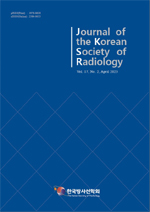
의료종사자의 COVID-19 예방 백신 접종받은 후 향후 매년 예방접종 의향에 미치는 요인
Factors Affecting Physicians who will be Vaccinated Every Year after Receiving the COVID-19 Vaccine in Healthcare Workers
- 한국방사선학회
- 한국방사선학회 논문지
- 제17권 제2호
- : KCI등재
- 2023.04
- 257 - 265 (9 pages)
본 연구의 목적은 코로나에 대한 일반적 특성에 따른 매년 백신접종 의향 여부, 백신접종 경험에 따른 매년 백신접종 의향 여부, 백신접종 관련 지식/태도에 따른 매년 백신접종 의향 여부, 매년 백신접종 의향에 부정적인 응답의 인자들을 파악함으로써 매년 예방접종 의향에 미치는 요인을 파악하기 위하여 2021년 1월경에 1개 K 대학병원을 대상으로 규격화한 설문을 통해 조사하였다. 통계분석은 일반적 특성, 백신접종 경험에 따른 제 변수 및 백신접종 관련 지식/태도에 따라 향후 COVID-19 백신접종을 매년 실시하라는 정책이 나오면 접종에 대한 의향은 빈도와 백분율을 산출하고 카이제곱 검정(-test) 시행하였고, 카이제곱 검정에서 유의했지만, 기대도수가 5보다 작은 범주가 25% 이상이면 피셔 정확 검정(Fisher’s exact test)으로 비율 차이 검정을 하였다. 단순 분석에 유의한 변수들을 이용한 다중 로지스틱 회귀분석을 통해 향후 백신 예방접종 여부의 예측모형과 각 독립 변수들이 미치는 효과 크기를 추정하였다. 단순 로지스틱 회귀분석에서 매년 백신접종 의향에 맞지 않겠다고 응답한 이유는 백신접종을 한 이유가 ‘나의 감염을 예방하기 위하여’ 응답한 경우보다 ‘가족과 병원 내원객의 감염 예방하기 위하여’의 응답한 경우가 11.0배 높았고 ‘지역사회와 국가의 집단면역 형성을 위하여’ 응답한 경우가 3.67배 높았다. 1, 2차 예방접종 후 경험한 이상 반응에서 접종 부위 통증 경험한 경우가 8.42배 높았고, 붓거나 발적 경험을 한 경우 4.00배, 관절통을 겪은 경우가 5.69배 피로감을 느낀 경우가 5.57배 높게 매년 접종 의향이 없었다. 또한 백신접종에 대한 불안 정도를 느낄수록 매년 백신을 맞지 않겠다는 의향이 2.94배씩 높았다.
The purpose of this study was to vaccinate every year according to the general characteristics of COVID-19, whether to vaccinate every year according to the vaccination experience, whether to vaccinate every year according to knowledge/attitude about vaccination, and negative responses to the vaccinate every year In order to understand the factors affecting the vaccination physician every year by identifying the factors of Statistical analysis is based on general characteristics, variables based on vaccination experience, and knowledge/attitudes related to vaccination. The doctor calculates the frequency and percentage, A square test (-test) was performed, and if the chi-square test was significant but the expected frequency was less than 5 for 25% or more, a ratio difference test was performed with Fisher's exact test. Through multiple logistic regression analysis using variables that were significant in simple analysis, a predictive model for future vaccination and the effect size of each independent variable were estimated. As statistical analysis software, SAS 9.4 (SAS Institute Inc., Cary, NC, USA) was used, and because the sample size was not large, the significance level was set at 10%, and when the p-value was less than 0.10, it was interpreted as statistically significant. In the simple logistic regression analysis, the reason why they answered that they would not be vaccinated every year was that they answered 'to prevent infection of family and hospital guests' rather than 'to prevent my infection' as the reason for the vaccination. It was 11.0 times higher and 3.67 times higher in the case of 'for the formation of collective immunity of the local community and the country'. The adverse reactions experienced after the 1st and 2nd vaccination were 8.42 times higher in those who did not experience pain at the injection site than those who did not, 4.00 times higher in those who experienced swelling or redness, and 5.69 times higher in those who experienced joint pain. There was a 5.57 times higher rate of absenteeism annually than those who did not. In addition, the more anxious they felt about vaccination, the more likely they were to not get the vaccine every year by 2.94 times.
Ⅰ. INTRODUCTION
Ⅱ. MATERIAL AND METHODS
Ⅲ. RESULT
Ⅳ. DISCUSSION
V. CONCLUSION
References